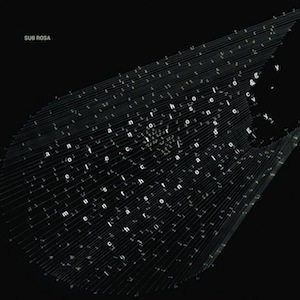 For its seventh and final volume, Sub Rosa’s mighty experimental music compilation has been expanded to a triple CD. At this point, I would have thought that all the good stuff would have been covered but label boss and Anthology curator Guy Marc Hinant has managed to uncover more startling curiosities from the last 150 years to make this series go out with a bang (and a drone and a blast of white hot feedback).
For its seventh and final volume, Sub Rosa’s mighty experimental music compilation has been expanded to a triple CD. At this point, I would have thought that all the good stuff would have been covered but label boss and Anthology curator Guy Marc Hinant has managed to uncover more startling curiosities from the last 150 years to make this series go out with a bang (and a drone and a blast of white hot feedback).
When the first volume of An Anthology of Noise & Electronic Music came out, I was just starting university and finding my way from mainstream metal and electronic music into the wilder world of music through groups like Einstürzende Neubauten and Throbbing Gristle. I noticed this compilation in Dublin's Road Records (unfortunately a thing of the past) and saw Neubauten was on the tracklist so I took a punt on it. It blew my mind and most of the material took me years to come around to. Fast forward to 2013 and I am still finding An Anthology of Noise & Electronic Music to be a challenge, even a slog at times. This has been the series’ strength in actually presenting music that represents a true avant garde sensibility (even if the avant garde it is documenting is largely six feet under at this point in time).
Like previous volumes, this seventh volume hopscotches around time and theme to create a baffling tapestry of recorded sound. Pieces from the 1950s like Henry Jacobs' "Sonata for Loudspeakers" and Bebe and Louis Barron’s "Bells of Atlantis" (which is stupendously good) represent the work of very enthusiastic amateurs (indeed the Barrons would go on to score the soundtrack for Forbidden Planet a few years later) whose pieces sit comfortably alongside "serious" academic works like Luciano Berio’s "Thema (Omaggio a Joyce)." Suddenly, we are dropped from this quaint world of tape experimentation into the future worlds of modern electronic music. Works by Benjamin Thigpen and Helmut Schäfer demonstrating how experimental music is continuing to develop, even if it lacks the same "shock of the new" as in former times.
Included as a footnote at the end of the first disc is the now legendary phonautograph recording by Édouard-Leon Scott de Martinville of a human voice singing "Au Claire de la Lune." Its place on this collection is at first strange, this is neither a piece of electronic music and Scott de Martinville was obviously trying to capture sound as oppose to corrupt it. Yet it is only through techniques developed through the exploration of electronics in relation to sound that is possible to hear this piece of history (it’s also not the most melodious things I have ever heard).
A sizeable portion of the compilation is given over to the electric guitar, the scourge of parents’ hearing the world over for decades. Alan Courtis and Justin Broadrick both demonstrate how the electric guitar is a perfect instrument for fooling around with in terms of bedroom setups and signal processing. Fausto Romitelli’s "Trash TV Trance," performed by Tom Pauwels, takes a different take on noisy guitar with its complex, frenetic playing simultaneously virtuoso and overwhelming. The cream of late '80s, early '90s indie guitar worship (namely Spacemen 3 and My Bloody Valentine) are also present in the form of E.A.R. whose line up for this recording is a dream team of Peter Kember, Kevin Shields, Kevin Martin, and Eddie Prévost. The guitars are not the focus here but are certainly integral to the piece as it unfolds slowly and beautifully through various psychedelic tones.
The pure noise end of the spectrum is also well catered for with a euphoric early piece by The New Blockaders; "Blockade is Resistance" purges the air like a holy fire and is confrontational even by today’s standards. More disturbing is Warong Rachapreecha’s "Shambles," which is just under a minute of a pig being slaughtered. Less distressing is "Skate" by The Rita where Sam McKinlay manages to combine the hypnotic sound of skateboarding with harsh noise. Taken together with similar works smattered throughout the series, any notion of noise being a homogenous wall of feedback is strongly contested. Even as someone who has spent a lot of time listening to this sort of music, the Anthology of Noise & Electronic Music has served to reignite my interests and reboot my auditory cortex.
What is surprising at the end of the series is not that Hinant has managed to miss out on seminal artists like Throbbing Gristle, Whitehouse, Keiji Haino, David Tudor, Coil, Nurse With Wound, Kraftwerk, Pierre Henry, Kurt Schwitters, Marcel Duchamp, Delia Derbyshire, etc. etc. but that their absence is only noticeable when you are writing a review for an online music magazine. While I am dismayed that there will be no future instalments in the series, I am still working my way through all the previous volumes to revisit and re-examine the artists included. This last volume contains as much, if not more, unfamiliar works as it does familiar which I imagine will mean an expensive few years of tracking more material down.
samples:
- Luciano Berio - Thema (Omaggio a Joyce)
- E.A.R. - Beyond the Pale
- GX Jupitter-Larsen/The Haters - Fuechen
 
Read More

